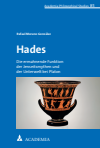Zusammenfassung
Diese Arbeit betrachtet Mythen anhand einer detaillierten Analyse der Jenseitsmythen des Gorgias, der Politeia und des Phaidons als diskursive Werkzeuge, die in ihrem dialogischen Kontext eine ermahnende Funktion erfüllen. Durch sie versucht der Erzähler des Mythos, seine Zuhörer von einem von philosophischen Tugenden geleiteten Leben zu überzeugen. Der Analyse der Mythen geht eine Untersuchung des platonischen Verständnisses des Hades in der Apologie und im Kratylos sowie der Anspielungen auf ihn im Protagoras voraus. Dieses Buch bietet eine einheitliche Sicht auf die Ver-wendung der Jenseitsmythen bei Platon. Rafael Moreno González lehrt Philosophie an der Pontificia Universidad Católica del Perú und der Universidad del Pacífico (Lima).
Abstract
This work considers myths through a detailed analysis of the afterlife myths of the Gorgias, Republic and Phaedo, as discursive tools that fulfil an admonitory function in their dialogical contexts. Through them, the narrator of the myth attempts to convince his listeners to lead a life guided by philosophical virtue. The analysis of the myths is preceded by the study of the Platonic understanding of Hades in the Apology and the Cratylus, as well as the allusions to it in the Protagoras. As a result, this book offers a unified view of the use of the afterlife myths in the Platonic dialogues. Rafael Moreno González teaches Philosophy at the Pontificia Universidad Católica del Perú (Lima) and the Universidad del Pacífico (Lima).
Schlagworte
Antike afterlife myths Antike Philosophie ancient philosophy Apologie antiquity Dialogischer Kontext Apology Cratylus Geschichte Gorgias dialogical context Griechenland Greece history Hades Jenseitsmythen myth analysis myths Kratylos Mythen Phaedo Mythenanalyse philosophy Mythos Plato Phaidon Platonic understanding tools Philosophie transcendence Platon underworld Platonisches Verständnis Politeia virtue Protagoras Transzendenz Tugend Unterwelt Werkzeuge- 13–24 Einleitung 13–24
- 327–332 Schlussbemerkungen 327–332
- 333–350 Literaturverzeichnis 333–350

